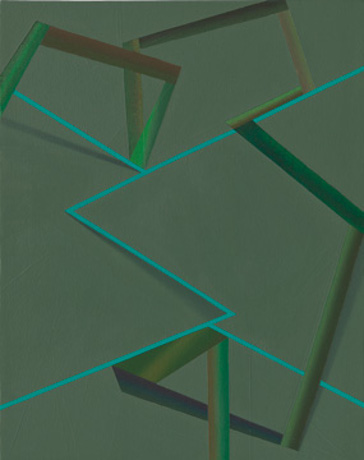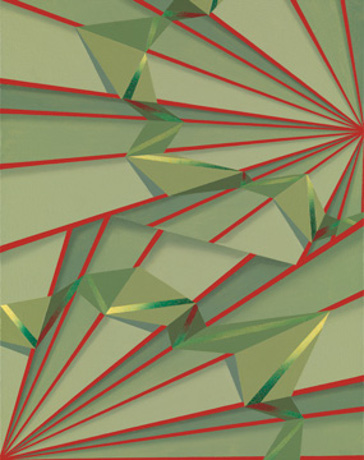
The Rigorous Art of Tomma Abts
Tomma Abts has managed a difficult feat: she makes paintings that are simple and straightforward that nonetheless hold the eye for long periods of time. The compositions contain a limited number of visual elements: curved arcs, geometric shapes, and linear patterns. The forms interplay with each other, creating dynamic arrangements that often trick the vision in subtle ways. The pictures are in harmony, and yet the closer you look, the more tension is revealed. That tension has less to do with the images themselves, and more to do with the physical qualities of the surfaces of the paintings. In her current self-titled retrospective, which is on view at Serpentine Galleries in London and will later travel to the Art Institute of Chicago, there is something so essentially painterly about her work that it is being hailed as a beacon of what a the next generation of contemporary abstract painting might be. The praise has something to do with the earnest originality of the artist herself. Abts is a progenitor; an artist who not only creates new works, but whose sincerity, work ethic, and openness also leads to the emergence of new ideas. The small-scale, nuanced works in this show do not scream their new ideas from the roof-tops, nor do they necessarily even demand our attention at all. They quietly declare their value, confident in the fact that anyone who takes the time to look carefully at them will be rewarded with visions of simple, timeless truths.
Reclaiming the Value of Process
The term “Process Art” emerged out of the cacophonous 1960s art world. It became a sort of blanket statement for any type of art in which the process of creation held primacy over the final art object. Variously over the years Performance Art, Conceptual Art, Land Art, Dada Art, Social Practice Art, and even Abstract Expressionism have all been described as types of Process Art. Essential to all of these styles is the notion that aesthetic objects are relics, material things to fetishize and trade, while the most valuable thing is the irreplaceable, one-of-a-kind human action that led to their creation. While this overall concept holds much philosophical weight, it also fundamentally denies the simple fact that people like to be around objects of art. In the vast majority of cases, the process that led to the creation of an artwork remains unknown to viewers. The so-called aesthetic relic is in reality the only thing most people will ever know about the work.

Tomma Abts. Feke, 2013. Private collection, New York © Tomma Abts. Courtesy of greengrassi, London.
I consider Abts a Process Artist, but a different type of process artist. She embraces the art object while also acknowledging process as pivotal. She holds herself accountable for making critical choices about exactly how she creates her works. Her method is well thought out and defined, and she is always working towards some concrete goal. Yet the genius of her work is that Abts is also fearless in her willingness to give in to the epiphanies that emerge out of her process. Even though she always begins with a defined starting point and specific goal, she remains open to the inspiration she receives from the act of painting itself. For this reason, every step along the way is to some degree guided by whatever surprises she encountered during the step before. Her paintings thus unfold slowly, even over the course of several years sometimes. Despite the rigor of her planning, the final composition remains unknown to her until the very end.

Tomma Abts. Moeder, 2005. Gift of Nancy Lauter McDougal and Alfred L. McDougal. © Tomma Abts. Courtesy of greengrassi, London.
Finding Relief
One of the most fascinating epiphanies to have emerged out of her open-ended process in recent years has to do with the uneven surfaces that frequently result from the layers she builds up on the surfaces of her paintings. Abts begins each work by applying a thin wash of acrylic paint, and then she slowly builds up additional thin layers using oil paint. She might start with a line and then over time she might decide to paint over that original line. When she does, a small ridge is created where the new layer of paint covers up that original line. Some painters would sand that ridge down to cover up the evidence of it, but Abts leaves it as an echo of time—a hint at the personal history of the composition. This is what gives the works in her retrospective their “painterly” quality. But Abts also recently saw something else in these ridges. No longer did she see them as simply markings of the past. She perceived them as potential beginnings of the future.

Tomma Abts. Inte, 2013. Private collection, Cologne. © Tomma Abts. Courtesy of greengrassi, London.
To express the potential she saw in her painterly ridges, Abts made a cast of one of her paintings and then rendered the cast in metal. Expressed in monochromatic aluminum, the ridges are no longer subjugated by the top layers of paint that once covered them up. Instead, they became the central component of the work. The painting becomes a relief sculpture, and yet hung on the wall next to its progenitors it also retains the qualities of its former self. This subtle innovation is one of the clearest expressions of the beauty of the process of becoming. It is an acknowledgement that the action of painting is similar to the mysteries that unfold within a cocoon. The natural processes of creation are wondrous and powerful, but they will never be as valuable as the life that emerges from that cocoon—the product of creation. For Abts, art becomes life—the inevitable conclusion when, like Abts, an artist embraces the role of progenitor, and surrenders to the mysteries of whatever the process of creation might produce. The retrospective exhibition Tomma Abts, which includes paintings from 2002 through 2017, as well as some of her new metal reliefs is on view at Serpentine Galleries in London through 9 September 2018, and at the Art Institute of Chicago from 19 October 2018 through 17 February 2019.
Featured image: Tomma Abts. Jeels, 2012. Collection of Sascha S. Bauer. © Tomma Abts. Courtesy of greengrassi, London.
All images used for illustrative purposes only
By Phillip Barcio






